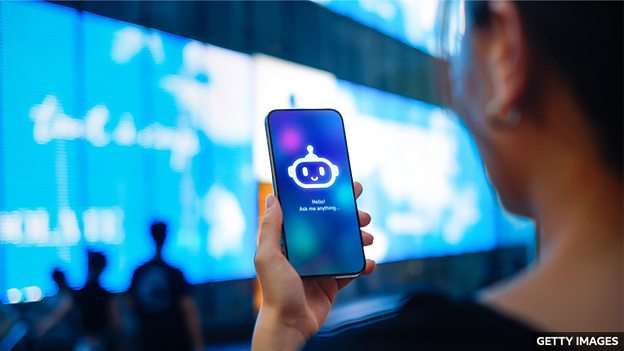人们对 “artificial intelligence(人工智能)” 是否会在未来成为一种特殊的生命形式态度不一。不过即使是现在,一些 “chatbot(聊天机器人)” 几乎已经达到了 “以假乱真” 的效果,能够让人产生自己是在和真正的人类聊天的错觉。本文浅谈为何有的人会把人工智能看作人类,以及可能随之而来的种种问题。
词汇:artificial intelligence 人工智能
1 After MIT Professor Joseph Weizenbaum created the chatbot Eliza, he became concerned that people who had used the programme started to act as if it was human. This might sound like a modern problem, but Eliza was created in 1966. If a programme from the 1960s was capable of tricking people into thinking it was human, what effect could the large-language-model-based chatbots of the 2020s have?
2 Modern philosophers and technology experts have discussed whether AI could develop consciousness. Sentience is difficult to define, but the fact that large language models respond by mathematically calculating the probability of certain patterns appearing suggests that it would be hard to consider them to be alive. However, in terms of our responses to them, what matters is not whether they are sentient, but whether they appear to be so.
3 Large language models are made up of genuine human interactions. While their tendency to hallucinate means that chatbots are not able to provide reliable factual information, they are able to effectively replicate the language used in human communication. Psychologists report that people tend to have a cognitive bias towards forming attachment and trust. Even sceptical technology writers report feeling some emotion towards AI chatbots. Some users have even reported grief when one model has been replaced by a newer one.
4 This combination of believable human language together with the inability to reliably assess facts can be dangerous.Cases have been reported where people have been encouraged by chatbots to do dangerous or illegal things. The chatbots were able to use language to encourage and persuade, but not identify or evaluate risks. Trust becomes dangerous when it is not accompanied by reason. Also, if people form relationships with AI, then they may spend less time and effort trying to cultivate genuine human relationships. Could the chatbot revolution lead to a world where we struggle to relate to each other?
测验与练习
一、将标题和段落配对。
Paragraph 1 _______
Paragraph 2 _______
Paragraph 3 _______
Paragraph 4 _______
a. Could AI be alive?
b. Not a new problem
c. Forming a connection
d. Jobs lost to AI
e. Dangers of AI
二、根据文章内容选出正确的选项。
1. Chatbots are a new invention.
a. True
b. False
c. Not given
2. AI responses are based on _______.
a. feelings
b. patterns
c. sentience
3. What does 'their' refer to in the following sentence? While their tendency to hallucinate means that chatbots are not able to provide reliable factual information, they are able to replicate the language used in human communication.
a. large language models
b. humans
c. chatbots
4. People are starting to trust AI psychologists more than real psychologists.
a. True
b. False
c. Not given
5. Trust can make AI dangerous.
a. True
b. False
c. Not given
三、用下列单词完成对本文的总结。
Some people wonder if AI could one day become 1) _______. The reality is that today large language models are based on 2) _______. However, because they are so successful at 3) _______ human communication styles, people think they can see AI's 4) _______. People's 5) _______ towards trust means they can start to believe that AI is human.
replicating
hallucinating
sentient
patterns
consciousness
sceptical
cognitive bias
(答案见词汇表后)
词汇表
chatbot 聊天机器人
large language model 大语言模型
consciousness 意识
sentience 感觉能力,知觉
probability 可能性
pattern 模式
sentient 有感知能力的
interaction 互动
hallucinate 出现幻觉
reliable 可靠的
replicate 复制,重现
cognitive bias 认知偏见
attachment 依恋
sceptical 持怀疑态度的
grief 悲伤,悲痛
assess 评价,评估
reason 判断力,理性
cultivate 培养
答案
一、将标题和段落配对。
Paragraph 1 b) Not a new problem
Paragraph 2 a) Could AI be alive?
Paragraph 3 c) Forming a connection
Paragraph 4 e) Dangers of AI
二、根据文章内容选出正确的选项。
1. b. False. This might sound like a modern problem, but Eliza was created in 1966.
2. b. Sentience is difficult to define, but the fact that large language models respond by mathematically calculating the probability of certain patterns appearing suggests that it would hard to consider them to be alive.
3. c. 'Their' refers forward to 'chatbots'.
4. c. Not given. The text does not mention AI psychologists.
5. a. True. Trust becomes dangerous when it is not accompanied by reason.
三、用下列单词完成对本文的总结。
Some people wonder if AI could one day become sentient. The reality is that today large language models are based on patterns. However, because they are so successful at replicating human communication styles, people think they can see AI's consciousness. People's cognitive bias towards trust means they can start to believe that AI is human.

